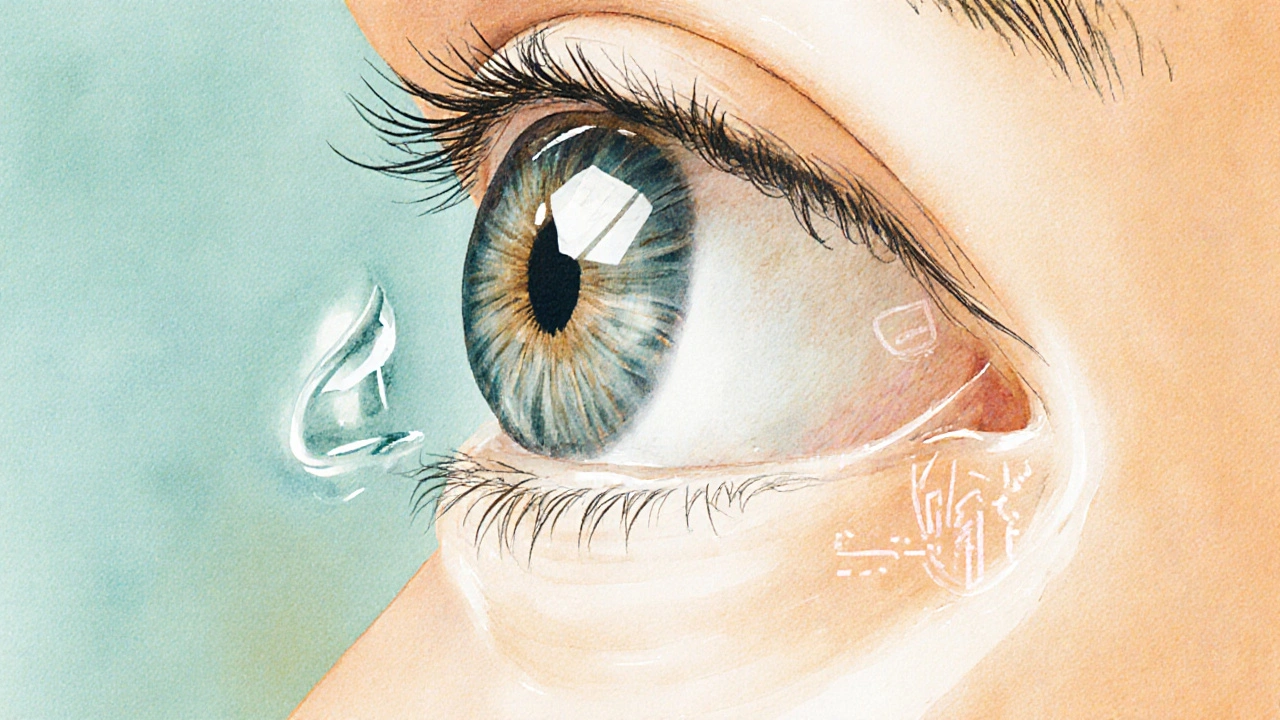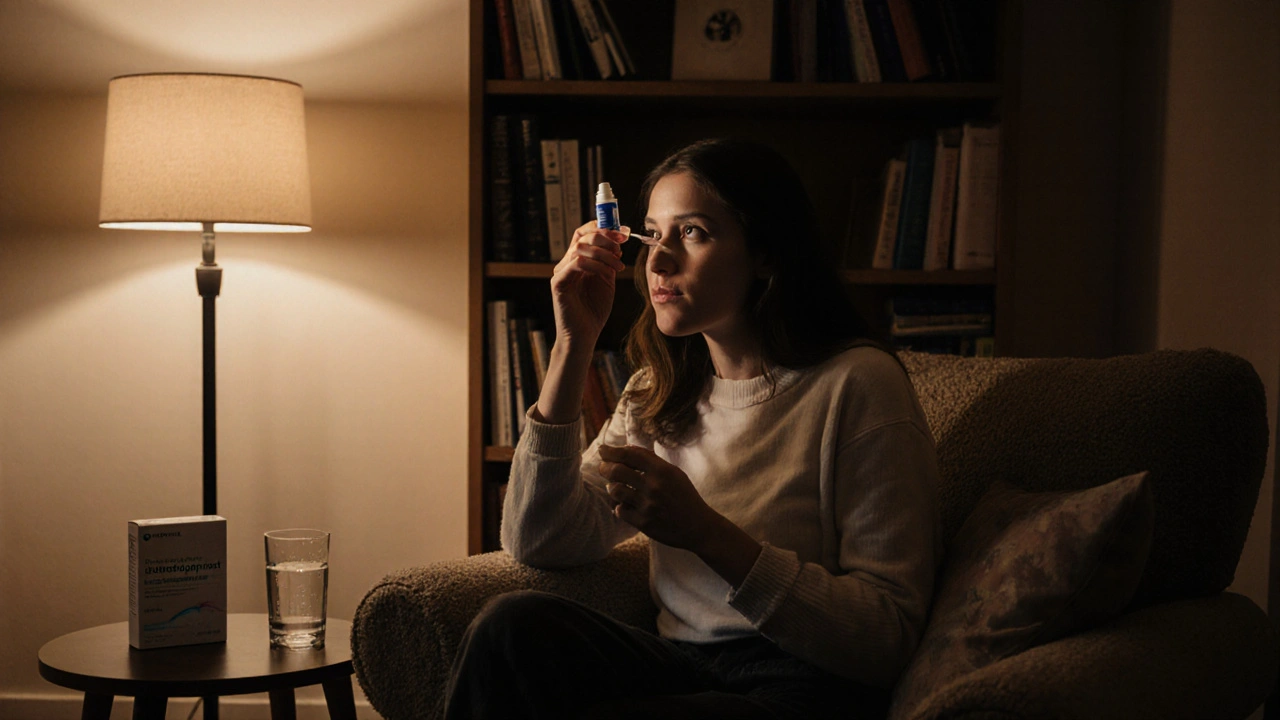
Latanoprost Daily Routine Tracker
Track your daily latanoprost usage and monitor for common side effects.
Did you take your latanoprost today?
Side Effect Monitoring
Quick Take
- Latanoprost is a once‑daily eye drop that lowers intraocular pressure (IOP) by improving fluid outflow.
- Most users notice a slight darkening of the iris and occasional eyelash growth.
- Stick to the same time each day - preferably bedtime - to keep pressure stable.
- Watch for redness, itching, or vision changes and contact your ophthalmologist promptly.
- Combine proper drop technique with lifestyle tweaks (e.g., swimming goggles, makeup adjustments) for smoother days.
Living with glaucoma often feels like a constant balancing act. One minute you’re reading the news, the next you’re worrying whether the next eye‑drop dose will cause a flare‑up. Latanoprost is a prostaglandin analog eye‑drop prescribed to reduce intraocular pressure in open‑angle glaucoma patients. Understanding how the medication works, what to expect, and how to weave it into your routine can turn that juggling act into a seamless part of your day.
What Latanoprost Actually Does
Glaucoma damages the optic nerve primarily because fluid builds up behind the eye, raising IOP. Intraocular pressure is the fluid pressure inside the eye that, when elevated, can compress optic nerve fibers and lead to vision loss. Latanoprost belongs to the Prostaglandin analogs are a class of eye‑drop medications that increase aqueous humor outflow through the uveoscleral pathway. By relaxing the tissues around the drainage channels, the drug lets fluid escape more easily, usually dropping IOP by 20‑30% within a few weeks.
How to Use the Drops Correctly
- Wash your hands thoroughly.
- Tilt your head back, pull down the lower eyelid to create a small pocket.
- Hold the bottle close to the eye without touching it.
- Press gently to release one drop into the pocket.
- Close your eye for about one minute, lightly pressing the inner corner to prevent drainage into the tear duct.
- Wait at least five minutes before applying any other eye medication.
Consistency is key: the medication works best when taken at the same time each day, usually before bedtime. The evening dose aligns with the eye’s natural nocturnal fluid dynamics, giving the drug a longer window to act.
Common Side Effects and How to Tame Them
Most users report mild, temporary changes. The most frequent Side effects include iris darkening, increased eyelash length, eye redness, and occasional eye discomfort. Here’s a quick cheat‑sheet for handling each:
- Darkening of the iris: This change is permanent but harmless. If the contrast bothers you, discuss tinted contact lenses with your ophthalmologist. \n
- Eyelash growth: Trim lashes if they become irritating, but many enjoy the fuller look.
- Redness or itching: Use preservative‑free artificial tears a few hours after the drop to soothe the surface.
- Blurred vision right after dosing: Wait a few minutes before reading or using screens; the effect usually fades quickly.
If you notice persistent pain, sudden loss of vision, or severe allergic reactions, stop the drops and call your eye doctor immediately.

Tips for Sticking to Your Routine
Turning a medical task into a habit can be surprisingly simple when you pair it with an existing daily cue:
- Night‑time cue: Keep the bottle on your night‑stand next to your toothbrush. The visual reminder makes it hard to miss.
- Smartphone alarm: Set a recurring reminder titled “Latanoprost” at your chosen time.
- Travel kit: Pack a small zip‑lock bag with the drop bottle, a mini eye‑dropper, and a travel‑size bottle of artificial tears. This avoids missed doses on the road.
- Family involvement: Let a partner or roommate know about your schedule; a simple “Did you take it?” check‑in can boost adherence.
Lifestyle Tweaks That Make a Difference
Glaucoma doesn’t have to dominate every activity. Small adjustments keep you comfortable while protecting your eyes:
- Swimming: Wear snug goggles to prevent water from irritating the eye surface. If you use contact lenses, remove them before swimming.
- Makeup: Apply eye makeup after the drop has settled (about 15 minutes). Use hypoallergenic products to limit irritation.
- Reading: Position books or screens at a comfortable distance; glare can amplify dryness after dosing.
- Exercise: Most low‑impact activities (walking, yoga) are safe. Heavy weight‑lifting may transiently raise IOP, so discuss any intense routines with your ophthalmologist.
When to Call Your Ophthalmologist
Your eye doctor isn’t just a prescriber; they’re a partner in monitoring disease progression. Reach out if you experience any of the following:
- Sudden flashes, floaters, or loss of peripheral vision.
- Persistent eye pain that doesn’t improve with artificial tears.
- Significant change in eye colour that makes you uncomfortable.
- Signs of infection - swelling, pus, or foul odor.
- Difficulty administering the drop after several weeks (hand tremor, poor vision).
Regular check‑ups (typically every 3-6 months) let your doctor adjust the pressure‑lowering regimen if IOP starts creeping up again.
How Latanoprost Stacks Up Against Other Prostaglandin Analogs
| Medication | Typical Dose Frequency | Average IOP Reduction | Common Side Effects |
|---|---|---|---|
| Latanoprost | Once daily (bedtime) | 25% | Irises darken, longer lashes, mild redness |
| Bimatoprost | Once daily (morning or night) | 30% | Eye irritation, eyelid skin darkening, hypertrichosis |
| Travoprost | Once daily (any time) | 24% | Conjunctival hyperemia, dry eye, peri‑ocular darkening |
All three drugs belong to the same class, but subtle differences in side‑effect profiles and potency can sway the choice. If iris darkening is a concern, Bimatoprost’s slightly higher efficacy might be worth the trade‑off. Talk with your Ophthalmologist about which option aligns best with your lifestyle and cosmetic preferences.
Key Takeaways for Everyday Success
Putting the pieces together creates a manageable routine:
- Administer the drop at the same time each night, using the step‑by‑step technique.
- Monitor for side effects; most are mild and resolve with simple measures.
- Set reminders and keep the bottle in a visible spot.
- Adjust daily habits-makeup, swimming, reading-to reduce irritation.
- Schedule regular follow‑ups and call your eye doctor if anything feels off.
With these habits, latanoprost becomes a quiet supporting actor rather than the starring drama in your day.

Frequently Asked Questions
Can I use latanoprost if I wear contact lenses?
Yes, but remove the lenses before applying the drop. Wait at least 15 minutes before putting them back in to avoid residue buildup.
How long does it take to see a pressure drop?
Most patients notice a measurable reduction within 4‑6 weeks. Your ophthalmologist will check IOP at follow‑up visits to confirm the effect.
Will the darkening of my iris affect my vision?
No, the colour change is purely cosmetic and does not impair visual acuity or peripheral vision.
Can I miss a dose and still keep my pressure under control?
Missing an occasional dose is unlikely to cause a spike, but make it a habit to take it daily. If you miss a night‑time dose, take it as soon as you remember unless it’s close to your next scheduled dose.
Is latanoprost safe for pregnant or nursing mothers?
There is limited data, so doctors usually avoid prescribing it during pregnancy or breastfeeding unless benefits clearly outweigh risks.






Kathy Butterfield
September 29, 2025 AT 01:12Thanks for the thorough guide! 😊
Zane Nelson
October 8, 2025 AT 07:25The exposition herein is commendably exhaustive, yet one discerns a paucity of primary literature citations to substantiate the asserted therapeutic thresholds. Moreover, the tone oscillates between layperson-friendly and inadvertently pedantic, which may bewilder the discerning scholar. A more rigorous delineation of the pharmacodynamics, perhaps via reference to seminal studies, would elevate the discourse. In sum, the piece serves as a functional primer, albeit lacking the gravitas befitting an erudite treatise.
Sahithi Bhasyam
October 17, 2025 AT 13:38Wow, this article really hit home!! :) I have been struggling with my latanoprost routine for months, and reading this felt like a lifeline. First, the step‑by‑step drop technique reminded me to press the inner corner of my eye after dosing – that little trick I always forget!!!
Second, the reminder to set an alarm on my phone is pure genius; I actually set a nightly alarm titled "Latanoprost" and now I never miss a dose.
Third, the side‑effect section gave me confidence to trim my new lashes instead of freaking out – I even bought a small pair of scissors.
Fourth, the tip about keeping the bottle on my night‑stand next to my toothbrush has become a habit; I see it and instantly remember.
Fifth, the travel kit suggestion was a game‑changer – I packed a zip‑lock bag with my drops, a mini eye‑dropper, and artificial tears before my last trip to Mumbai, and I never felt uneasy about missing a dose!
Sixth, I appreciate the advice on waiting five minutes before using another eye medication – I used to rush and wonder why my eyes felt gritty.
Seventh, the table comparing prostaglandin analogs clarified why my doctor chose latanoprost over bimatoprost; the slightly lower risk of eyelid skin darkening was reassuring.
Eighth, the note on not putting contacts back in for 15 minutes made sense; I used to pop them in too quickly and felt irritation.
Ninth, the reminder to contact the ophthalmologist if I see flashes or sudden pain saved me from panic – I now know exactly what to watch for.
Tenth, the lifestyle tweaks – especially wearing snug goggles while swimming – made me feel like I can still enjoy water activities without fear.
Eleventh, the emphasis on regular follow‑ups motivated me to book my next appointment three months early.
Twelfth, the FAQ about pregnancy was informative; I shared it with my sister who is expecting and worried about medication safety.
Thirteenth, the suggestion to use preservative‑free artificial tears after dosing reduced my evening redness dramatically.
Fourteenth, the simple language mixed with detailed steps made the article accessible yet thorough – a rare combination.
Fifteenth, the overall tone feels supportive, not condescending, which is exactly what patients need.
Finally, thank you for the comprehensive guide – I feel empowered to manage my glaucoma with confidence! :)
mike putty
October 26, 2025 AT 18:52Great rundown! I’ve been battling glaucoma for a while and it’s nice to see a piece that balances practical tips with empathy. Keep the positive vibe coming, it really helps people stay on track.
Kayla Reeves
November 5, 2025 AT 01:05Adherence to medication is not just a personal choice; it’s a moral responsibility to preserve one’s sight and not waste the resources of the healthcare system. Skipping doses shows a reckless disregard for the sanctity of vision. The article wisely stresses daily consistency, but readers must internalize that this is an ethical imperative. Let’s all hold ourselves accountable.
Abhinanda Mallick
November 14, 2025 AT 07:18In the grand tapestry of our nation’s health, safeguarding the eyes of its citizens is tantamount to protecting its very future. This guide, while seemingly mundane, is a battle cry for ocular vigilance! One must approach latanoprost not merely as a drop, but as a patriotic duty-administer it with ceremony, set the alarm like a siren, and defend against the insidious rise of intra‑ocular pressure as though defending our borders. Let every citizen treat their eyes with the same fervor we reserve for national anthems.
rachel mamuad
November 23, 2025 AT 13:32From a compliance standpoint, the IOP‑modulation data aligns with current pharmaco‑dynamic models. However, note the typographical oversight in the side‑effect table – “eyelash growh” should be “growth”. Also, the jargon around “uveoscleral outflow” could be clarified for lay‑readers. Overall, the guide is a robust framework for patient‑centred care.
Amanda Anderson
December 2, 2025 AT 19:45This is simple and clear – exactly what I needed. The drama of eye drops suddenly feels manageable, and I’m ready to stick to the routine.
Carys Jones
December 12, 2025 AT 01:58Honestly, the hype around latanoprost’s side‑effects is overblown. Darkening of the iris is a cosmetic myth that many obsess over, while the real issue is that patients become overly dependent on a single medication. We should question the industry’s push for lifelong monotherapy.
Roxanne Porter
December 21, 2025 AT 08:12I appreciate the emphasis on ethical responsibility, but let’s also recognize that many patients face barriers to consistent dosing, such as cost or limited access to pharmacies. Collaborative support-like community reminder groups-can bridge that gap and ensure everyone upholds their ocular health duties.